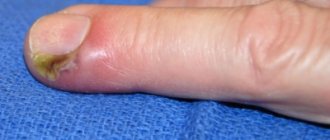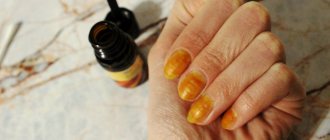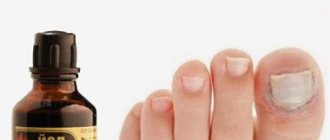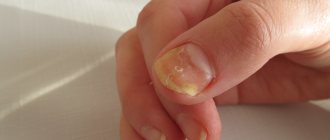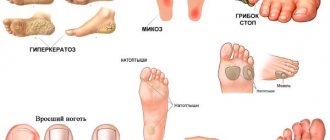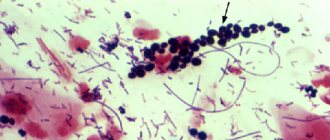Just a few years ago, fungal nail diseases were not given much importance, whereas now everyone understands the need for timely detection and treatment of a massive contagious fungal infection caused by a variety of dermatophyte fungi. Thanks to widespread public awareness, the number of visits to specialists with this pathology has increased, which in turn has led to an increase in the detection of mycoses of the feet. Since any deformation of the nail plate for no apparent reason (for example, injury) is primarily suspected of a fungal infection, self-diagnosis in this case is a decisive factor. Thus, any change in the nail plate is a reason to contact a dermatologist, because at least half of such disorders will have a fungal etiology, and the rest will require careful diagnosis, again carried out by a specialist.
Why, given the obvious simplicity of clinical diagnosis of fungal nail infections, do patients usually come to the appointment already with advanced forms of the disease? Most often, 4-5 toes are affected, with the most affected nail plate (usually the first toe) changed by more than half, and its thickening is about 2 mm. Such symptoms require long-term combined treatment, which is reflected in its cost. Factors leading to this situation:
1. Actually, fungal nail infection is a sluggish disease that does not lead to life-threatening conditions and does not cause pain or discomfort. More often it affects the elderly population, who often associate changes in appearance with the aging process.
2. The sick themselves are often embarrassed by the disease, are not prepared for the financial costs of treatment, or are confident that it is incurable. Many people begin to self-medicate and do not see the disease as a reason to see a specialist.
3. Since the disease primarily affects the feet, even during medical examinations or examinations by doctors, the matter usually does not reach the point of examining the feet directly, without specific patient complaints about changes in the nails. This is facilitated by the extremely short time allotted for seeing patients even in specialized institutions, which, unfortunately, forces doctors to examine them only for the main reason for the visit.
Fungal infection of nails lasts quite a long time
Therefore, the earlier the disease is detected, the higher the likelihood of its complete cure. In addition, an earlier start of therapy allows us to limit ourselves to the use of only external preparations and nail cleanings, and this is only possible if the infection has affected single nails from the distal or lateral edges of less than 1/3-1/2 of the plate. Local external therapy is used to treat the initial stages of fungal nail infection. Advanced forms of fungal infection require longer and more expensive treatment. Periodic preventive examinations and medical examinations of the population play a special role in the early detection of nail mycoses.
Indications and contraindications
Baths for toenail fungus are recommended if the disease has just begun to develop. In severe cases, folk recipes will not help. In this case, it will be possible to eliminate fungal pathology exclusively with tablets in combination with ointments and creams.
Foot baths for fungus should not be performed by people who suffer from the following diseases:
- Diabetes.
- Vascular pathologies.
- Serious disturbances in the functioning of the heart.
- High body temperature.
- High blood pressure.
- Malignant neoplasms.
- Exacerbation of chronic diseases.
- An allergic reaction to the ingredients used in the preparation of the folk remedy.
Each component used for baths has its own contraindications. It is worth familiarizing yourself with them in advance.
Causes of pathology
- Frequent nail injuries.
- Wearing tight shoes.
- Diabetes mellitus and other endocrine pathologies.
- Hereditary dysfunctions.
- Psoriasis, lichen planus, ichthyosis, keratoderma, papillomatosis, chronic eczema.
- Imbalance of vitamins and microelements.
- Insufficient hygiene.
- Imbalance of the intestinal genome, including after treatment with antibiotics.
- Unbalanced diet.
- Sleep disturbances.
- Severe stress.
- Allergy to cosmetics.
As a rule, the disease develops against the background of a fungal infection of the nail, often against the background of immunodeficiency.
Basic rules for conducting procedures
Foot baths against fungus must be done in compliance with some recommendations, then they will be effective:
- Take foot baths daily. Their duration must be at least 15 minutes.
- Carry out procedures before going to bed.
- Use only boiled water for baths. It shouldn't be hot or cold. The temperature is selected so that the skin is comfortable.
- Before taking a foot bath, wash your feet with laundry soap.
- In case of fungal infection, it is recommended to first remove the dead layer of the epidermis with pumice, then steam the feet. After removing dead skin cells, discard the pumice stone.
- If the fungus has infected the nail plates, you will need to trim off the affected areas before bathing. After this, it is important to treat the scissors with disinfectants.
After the procedure, it is recommended to apply an antifungal drug to the affected skin or nail.
How to tell if there is fungus on your nails
Onychomycosis is the medical name for fungal infection of the nails. How to recognize it?
If the nail becomes cloudy and brittle, white spots have formed on it, and the skin around it turns red or begins to itch - these are symptoms, as well as the first stage of the development of the fungus.
During the first stage, the nail will become denser and thicker, and irregularities will appear on it. During the second stage of fungal development, the nail plate will lose its strength and can be easily removed with a scraper. It will begin to gradually move away from the cuticle, and the skin will become inflamed.
If treatment for the fungus is started, the nail will begin to deteriorate and may even move away from the finger.
Baths for foot fungus: effective recipes
To eliminate fungal infections on the lower extremities, baths with different components are performed. The most effective means are those described below.
With sea salt
To prepare a solution for a foot bath, you need to take 3 liters of warm water and dissolve 150 g of sea salt in it. Immerse your feet in a saline solution for 20 minutes. If you don’t have such salt at home, you can use table salt. But then you will need a different proportion: a tablespoon of product per liter of water.
To achieve a higher effect when treating foot skin fungus with a salt remedy, it is recommended to add a glass of chamomile or pine decoction or a large spoonful of ground cinnamon to the basin.
Reviews from real people
Is it possible to cure nail fungus? What do people say about this?
Feedback on the forum
Feedback on the forum
Feedback on the forum
Feedback on the forum
Feedback on the forum
Feedback on the forum
Feedback on the forum
Feedback on the forum
Feedback on the forum
Feedback on the forum
There are a lot of reviews. But all people are sure that it is quite possible to cope with the fungus.
Preventive measures
Fungal infection is difficult to treat, so it is better to prevent it. For prevention, doctors advise:
- Use your own rubber slippers when visiting public places: swimming pool, bathhouse, sauna, etc.
- To try on shoes in a store, wear socks or ankle boots.
- Avoid using socks made from synthetic materials. Synthetics cause increased sweating, which is a provoking factor for the proliferation of fungal spores. Socks made of cotton or bamboo would be ideal.
- Buy shoes made from natural materials that allow air to pass through.
- Change socks daily.
- Use special products to treat the skin to prevent excessive sweating.
- Strengthen the immune system by following the principles of a healthy diet, leading an active lifestyle, and giving up bad habits.
- Trim your nails in a timely manner - approximately once every 1-2 weeks.
If signs of fungus appear, you should immediately consult a doctor and begin treatment. The more advanced the disease, the more difficult it is to cure.
General tips for use
Traditional medicine offers a number of combinations of salt with other products and substances, which are also famous for their beneficial properties. But you can also use it separately. For example, for onychomycosis, it is recommended to take hot baths in which infected limbs should be steamed. This procedure allows you to soften the nail plate, thereby increasing its permeability. This means that the active substances of antifungal drugs can, after such preparation, penetrate into the deep layers of the nail and skin. In addition, salt will disinfect affected and healthy tissues, thereby preventing the development of a secondary infection.
It is necessary to use folk recipes, the main ingredient of which is salt, strictly according to the instructions. You should also adhere to the correct dosage of all components.
Recommendations for use
We list the main points that are important to consider when treating onychomycosis with salt:
- Recipes using sodium chloride may only have an additional status in the fight against fungal infections. Their prescription is justified against the background of the main treatment with local fungicidal and fungistatic drugs.
- If we are talking about an advanced form of the disease, complex therapy with the use of systemic antimycotics is necessary. In this case, recipes with salt, used as an independent remedy, will be practically useless.
- Sodium chloride and any components included in baths and lotions are prohibited if the patient has individual hypersensitivity to them.
- To consolidate the results obtained, the procedures must be repeated at least 10 times. You should not interrupt the course of treatment if the first signs of improvement are visible.
- Fungal infections have the ability to recur frequently. After the main therapeutic effect has been carried out, salt is recommended to be used as a prophylactic agent in the form of recipes listed in this article.
The effectiveness of salt in advanced stages of fungus
In case of old chronic infection, salt should not be used as an independent remedy. It is impossible to cope with deep damage to the stratum corneum using external methods, especially folk ones. In such a situation, only a systemic approach in the form of antimycotics intended for oral administration can solve the problem.
This is due to the fact that the fungus lives not only in the thickness of the nail plate. If a person refuses to treat a disease for a long time for some reason, infectious agents penetrate inside the body, spreading through the general bloodstream into its individual systems. As a result, local treatment of onychomycosis turns out to be useless, since external preparations cannot affect the pathogen from the inside.
Which salt should you choose?
To combat onychomycosis, it is recommended to use the following types of products.
| Name of salt | Description |
| MARINE | Effectively softens and disinfects nails affected by fungus. Prepares them for treatment with local antimycotics. |
| COOK | Destroys infection thanks to its fungicidal effect, reduces the area of inflammation and swelling. Blocks the activity of pathogenic microflora. Can cure onychomycosis at an early stage. |
| IODIZED | Softens the stratum corneum of the nail, destroys pathogenic bacteria, and prevents the spread of infectious agents. Recommended as a therapeutic and prophylactic agent in the fight against mycosis of the feet. |
| ENGLISH | Known as "magnesia". Promotes cleansing and healing of nails and skin affected by fungus, improves exfoliation of the stratum corneum. Recommended exclusively for the prevention of onychomycosis. |
| FLAVORED | Essential oils, such as tea tree extract, are usually added to the product. This product is endowed with strong antibacterial properties, fights the symptoms of onychomycosis, and eliminates unpleasant odors. Recommended as an auxiliary method for combating nail fungus. |
Traditional healers claim that ordinary gray salt is considered the most effective. Despite its unattractive appearance, its beneficial properties are much more pronounced than those of a finely ground snow-white product.
The dull tint of salt comes from algae remaining in it as a result of poor cleaning. This remedy has a powerful antioxidant effect and is ideally suited for the treatment of onychomycosis.
To choose a truly high-quality product, you need to pay attention to the following points:
- Packaging with preserved tightness without tears or dents.
- The contents of the pack should flow easily and be pliable. If the salt in a bag or box has the shape of a lump, it means that it was stored in conditions of high humidity and it has partially lost its beneficial qualities.
- The color of the product must be natural. A product that is snow-white or painted in bright shades is a common marketing ploy that has nothing to do with its healing capabilities.
- Salt should not have any foreign odor.
Treatment of contaminated items (disinfection)
During and after treating a fungal infection, it is very important to disinfect everything that the fungus has come into contact with. Floors, walls, equipment in baths, showers, bathrooms, as well as the patient’s personal belongings: underwear, shoes, skin and nail care items should be disinfected.
The walls and bottom of the bath should be treated with a mixture of equal parts of washing powder and bleach or chloramine, diluted to a creamy consistency (the powder should be washed off after 30 minutes). You can also use a 5% solution of chloramine or bleach, or a 3% solution of Lysol.
It is recommended to treat shoes with solutions of formaldehyde (25%) or acetic acid (40%). You should thoroughly wipe the insoles and side areas of the shoes with a moistened swab. Then place the tampon in the toe of the shoe, and place the shoe itself in a hermetically sealed plastic bag for 24 hours. After using acetic acid or a 25% formaldehyde solution, the shoes are ventilated or wiped with ammonia to eliminate the odor.
Underwear, stockings, socks, tights can be disinfected by boiling for 15-20 minutes in a 2% soap-soda solution. Then they should be ironed with a hot iron.
Nail scissors are disinfected by immersing them in alcohol and then burning them over a burner flame.
Sources
- Gupta AK., Quinlan EM. Google search trends in onychomycosis: Influences of flip flops and advertising. // J Cosmet Dermatol - 2020 - Vol19 - N10 - p.2736-2744; PMID:32615640
- Bulson JM., Liveris D., Derkatch I., Friedman G., Geliebter J., Park S., Singh S., Zemel M., Tiwari RK. Non-thermal atmospheric plasma treatment of onychomycosis in an in vitro human nail model. // Mycoses - 2022 - Vol63 - N2 - p.225-232; PMID:31677288
- Zalacain A., Merlos A., Planell E., Cantadori EG., Vinuesa T., Viñas M. Clinical laser treatment of toenail onychomycoses. // Lasers Med Sci - 2022 - Vol33 - N4 - p.927-933; PMID:28378259
- LaSenna CE., Tosti A. Patient considerations in the management of toe onychomycosis - role of efinaconazole. // Patient Prefer Adherence - 2015 - Vol9 - NNULL - p.887-91; PMID:26170638
- Chabasse D., Pihet M. . // J Mycol Med - 2014 - Vol24 - N4 - p.261-8; PMID:25458362
- Angamuthu M., Nanjappa SH., Raman V., Jo S., Cegu P., Murthy SN. Controlled-release injectable containing terbinafine/PLGA microspheres for onychomycosis treatment. // J Pharm Sci - 2014 - Vol103 - N4 - p.1178-83; PMID:24497012
- Ortiz AE., Avram MM., Wanner MA. A review of lasers and light for the treatment of onychomycosis. // Lasers Surg Med - 2014 - Vol46 - N2 - p.117-24; PMID:24375507
- Willyard C. Companies go toe to toe, as topical treatments for nail fungus bloom. // Nat Med - 2013 - Vol19 - N7 - p.794-5; PMID:23836202
- Sigurgeirsson B., van Rossem K., Malahias S., Raterink K. A phase II, randomized, double-blind, placebo-controlled, parallel group, dose-ranging study to investigate the efficacy and safety of 4 dose regimens of oral albaconazole in patients with distal subungual onychomycosis. // J Am Acad Dermatol - 2013 - Vol69 - N3 - p.416-25; PMID:23706639
- Singal A., Khanna D. Onychomycosis: Diagnosis and management. // Indian J Dermatol Venereol Leprol - 2012 - Vol77 - N6 - p.659-72; PMID:22016272
Use for children, pregnant and lactating women
Topical use of sodium chloride is not contraindicated in children and women during pregnancy and breastfeeding. Restrictions may apply to auxiliary components used in recipes along with salt, for example, iodine solution. It is known that this substance has the ability to be actively absorbed into the body through the skin and, if there is an excess in the blood, have a negative effect on the functioning of the thyroid gland.
For children, expectant and nursing mothers, it is better to use recipes exclusively with added salt without any additional ingredients.



